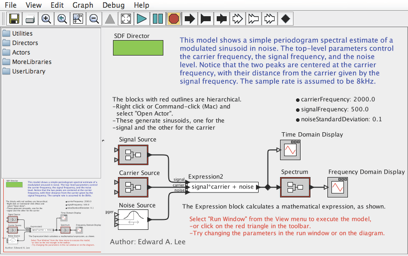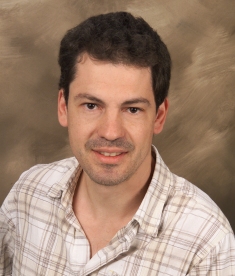Ptolemy Tutorial: Exploring Models of Computation with Ptolemy IISunday, October 24, 2010, Scottsdale, AZHeld in conjunction with Embedded Systems Week The tutorial materials may be found at:
|


|
Abstract
The Ptolemy project studies modeling, simulation, and design of concurrent, real-time, embedded systems. The focus is on assembly of concurrent components. The key underlying principle in the project is the use of well-defined models of computation that govern the interaction between components. A major problem area being addressed is the use of heterogeneous mixtures of models of computation.
Ptolemy II takes a component view of design, in that models are constructed as a set of interacting components. A model of computation governs the semantics of the interaction, and thus imposes an execution-time discipline. Ptolemy II has implementations of many models of computation including Synchronous Data Flow, Kahn Process Networks, Discrete Event, Continuous Time, Synchronous/Reactive and Modal Models
This hands-on tutorial explores how these models of computation are implemented in Ptolemy II and how to create new models of computation such as a “non-dogmatic” Process Networks example and a left-to-right execution policy example.
Introduction
Ptolemy II [1][6] is an open-source software framework supporting experimentation with actor-oriented design. Actors are software components that execute concurrently and communicate through messages sent via interconnected ports. A model is a hierarchical interconnection of actors. In Ptolemy II, the semantics of a model is not determined by the framework, but rather by a software component in the model called a director, which implements a model of computation. The Ptolemy Project has developed directors supporting process networks (PN), discrete-events (DE), dataflow (SDF), synchronous/reactive(SR), rendezvous-based models, 3-D visualization, and continuous-time models. Each level of the hierarchy in a model can have its own director, and distinct directors can be composed hierarchically. A major emphasis of the project has been on understanding the heterogeneous combinations of models of computation realized by these directors. Directors can be combined hierarchically with state machines to make modal models [2] [7]. A hierarchical combination of continuous-time models with state machines yields hybrid systems [3]; a combination of synchronous/reactive with state machines yields StateCharts [4] (the Ptolemy II variant is close to SyncCharts).
Ptolemy II has been under development since 1996; it is a successor to Ptolemy Classic, which was developed since 1990. The core of Ptolemy II is a collection of Java classes and packages, layered to provide increasingly specific capabilities. The kernel supports an abstract syntax, a hierarchical structure of entities with ports and interconnections. A graphical editor called Vergil supports visual editing of this abstract syntax. An XML concrete syntax called MoML provides a persistent file format for the models. Various specialized tools have been created from this framework, including HyVisual (for hybrid systems modeling), Kepler (for scientific workflows), VisualSense (for modeling and simulation of wireless networks), Viptos (for sensor network design), and some commercial products. Key parts of the infrastructure include an actor abstract semantics, which enables the interoperability of distinct models of computation with a well-defined semantics; a model of time (specifically, super-dense time, which enables interaction of continuous dynamics and imperative logic); and a sophisticated type system supporting type checking, type inference, and polymorphism. The type system has recently been extended to support user-defined ontologies [5]. Various experiments with synthesis of implementation code and abstractions for verification are included in the project.

An example of a Vergil window. Vergil is a graphical
editor for Ptolemy II.
Speakers
 |
Edward A. Lee, (http://ptolemy.org/~eal)
Edward A. Lee is the Robert S. Pepper Distinguished Professor of the Electrical Engineering and Computer Sciences (EECS) department at U.C. Berkeley. His research interests center on design, modeling, and simulation of embedded, real-time computational systems. He is the director of the Ptolemy project. |
 |
Stavros Tripakis (http://www-verimag.imag.fr/~tripakis)
Stavros Tripakis is Associate Research Scientist at UC Berkeley. His work lies in the areas of embedded, real-time and distributed systems, model-based and component-based design, verification, testing and synthesis. |
 |
Christopher Brooks (http://ptolemy.org/~cxh)
Christopher Brooks is the Ptolemy Project Software Manager and the Executive Director of the the Center for Hybrid and Embedded Software Systems (CHESS). |
Topics
The tutorial is a hands-on tutorial of 3 to 3.5 hours on Sunday, October 24th, 2010.Attendees should bring their own laptops.
- (13:00-14:00) Setting up Ptolemy II 8.0 and Eclipse: installing Eclipse; configuring Ptolemy; compiling Ptolemy; running a model within Eclipse. (We will provide USB sticks with Windows, Mac and Linux binaries)
- (14:00-15:00) Overview of Models of Computation in Ptolemy II: abstract semantics; actors and directors; currently implemented models of computation (Synchronous Data Flow, Dynamic Data Flow, Kahn Process Networks, Discrete Event, Continuous Time, Synchronous/Reactive and Modal Models); combining models of computation.
- (15:00 -15:30) Break
- (15:30 -17:00) Extending Ptolemy Models of Computation: Ptolemy execution semantics object model; using Eclipse to extend Ptolemy; building a non-dogmatic Kahn Process Networks model of computation; building a left to right model of computation.
The tutorial is similar to material presented at the February, 2009 Ptolemy Miniconference tutorial and at the February, 2007 Ptolemy Miniconference tutorial.
References
[1]
Johan Eker, Jorn Janneck, Edward A. Lee, Jie Liu, Xiaojun
Liu, Jozsef Ludvig, Sonia Sachs, Yuhong Xiong.
Taming heterogeneity - the Ptolemy approach,
Proceedings of the IEEE, 91(1):127-144,
January 2003.
(Key citation for the Ptolemy project)
[2] Edward A. Lee. Finite State Machines and Modal Models in Ptolemy II, Technical report, EECS Department, University of California, Berkeley, UCB/EECS-2009-151, December, 2009.
[3] E. A. Lee and H. Zheng, "Operational Semantics of Hybrid Systems," Invited paper in Proceedings of Hybrid Systems: Computation and Control (HSCC) LNCS 3414, Zurich, Switzerland, March 9-11, 2005, pp.25-53.
[4] E. A. Lee, H. Zheng, "Leveraging Synchronous Language Principles for Heterogeneous Modeling and Design of Embedded Systems," EMSOFT '07, September 30 - October 3, 2007, Salzburg, Austria.
[5] M.-K. Leung, T. Mandl, E. A. Lee, E. Latronico, C. Shelton, S. Tripakis, and B. Lickly, "Scalable Semantic Annotation using Lattice-based Ontologies," ACM/IEEE 12th International Conference on Model Driven Engineering Languages and Systems (MODELS), Denver, CO, USA, 4-9 October, 2009.
[6]Christopher Brooks, Edward A. Lee. Ptolemy II - Heterogeneous Concurrent Modeling and Design in Java, 11 February, 2010; Poster presented at the 2010 Berkeley EECS Annual Research Symposium (BEARS).
[7] Edward A. Lee. S. Tripakis. "Modal Models in Ptolemy". In EOOLT 2010 3rd International Workshop on Equation-Based Object-Oriented Modeling Languages and Tools. Linkoping University Electronic Press, October 2010. To appear.
Please direct questions to cxh at eecs berkeley edu
